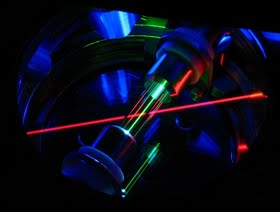T h o r i u m I o n T r a p p i n g
While typical nuclear excitation energies are in the keV to MeV range, there are exceptional cases where the excitation energies are much lower. Of particular interest is thorium-229, which, uniquely, has a metastable excited state < 10 eV above the ground state. The existence of a very low-lying isomeric state in the 229Th nucleus was first proposed by Kroger and Reich in 1976. They established that the energy of this state was less than 100 eV above the ground state. In 1994, the energy of this state was indirectly determined to be 3.5 +/-1 eV via spectroscopy of gamma rays emitted from alpha decay of 233U. This measurement motivated numerous studies relating to the unique prospect of controlling nuclear matter with optical radiation. Several experimental searches for optical emission in this range undertaken in the past ten years were unsuccessful or inconclusive.

229Th3+ Grotrian diagram of electronic energy levels and electric-dipole transitions including both nuclear ground and excited isomeric manifolds. Direct nuclear magnetic-dipole (M1) decay channels and electron-bridge pathways, suitable for initial nuclear excitation, are shown. Optical wavelengths are in nm.
Recently, a refined gamma ray spectroscopy measurement employing new detector technology has established the energy splitting to be 7.6 +/-0.5 eV, likely explaining the lack of direct isomer observation in earlier experiments. This recent result has stimulated various efforts around the world toward direct observation of the nuclear transition, with the most common methods being fluorescence detection from detection from 229Th-doped crystals, optical excitation in trapped 229Th+, and optical excitation in trapped 229Th3+.
The triply charged ion system is utilized in the Kuzmich Lab due to the specific advantages it brings: the monovalent character of Th3+ is amenable to direct laser cooling, allowing for a high degree of ion localization for efficient laser spectroscopy with tightly focused laser beams and for efficient state detection, and ii) a single 229Th3+ ion is an ideal system for high-accuracy clock operation, with potential for inaccuracy approaching the 10-20 scale. It has been suggested that the nuclear transition may be extraordinarily sensitive to variation of fundamental constants (particularly the fine structure constant) due to the interplay of the strong and electroweak interactions inside this nucleus. This further enhances the value of a high-performance nuclear clock using a single laser cooled 229Th3+ ion, as the most sensitive test for variation of the fine structure constant involves monitoring the ratio of frequencies derived from highly accurate atomic clocks with drastically different sensitivities to variation of the constant.

Wigner crystals of 229Th3+ and 232Th3+ ions confined in a linear rf trap. Isotopic fluorescence control is achievable due to the large relative isotope shifts and narrow atomic transition widths, Doppler broadening, and laser spectra. Note the ultracold phase of the dark ions is maintained due to sympathetic cooling from the bright ions which are directly laser cooled.
In order to initially locate and optically excite the nuclear isomer, the ions are to be laser cooled and well-localized, a task first demonstrated by our group with both 232Th3+ and 229Th3+. These were the first demonstrations of laser cooling multiply charged ions. Additionally, the so-called electron bridge (EB) may be utilized in order to transfer the isomer search range from the challenging DUV spectral region to the more manageable UV, visible, and/or NIR regions. In this case, hyperfine-induced mixing of the nuclear ground and isomer manifolds opens electric-dipole transitions between the two, providing a range of nuclear excitation options.
Once located, a single ion within a linear crystallized chain can be excited to the isomer manifold and its hyperfine structure and isomeric field shifts may be accurately measured. This knowledge would allow both for unambiguous identification of the isomer level and for an empirical determination of the isomer transition sensitivity to variation of the fine structure constant.

Partial energy-level diagram of the 5F5/2 electronic ground levels within the nuclear ground and isomer manifold of 229Th3+. By averaging the frequencies of the two transitions between stretched states, a virtual clock transition is formed which is extremely resilient to external-field perturbations.
In conventional optical atomic clocks, the most significant external-field clock shifts arise due to differences in the clock state electronic wavefunctions. Due to the smallness of the nucleus as compared to the large electron cloud, the nuclear transition in 229Th may be utilized in an optical clock of unprecedented accuracy. When utilizing the stretched states of a given valence electron orbital in 229Th3+, the electron cloud is the same for all clock states, leading to significant suppression of all external-field clock shifts. Additionally, narrow cooling transitions and the large mass of thorium lend themselves to significant suppression of the second-order Doppler (time dilation) shift, a leading systematic in single-ion clocks. Ultimately, clock inaccuracy approaching the 10-20 scale appears viable with current ion clock technologies applied to a 229Th3+ system where stretched states are used.

